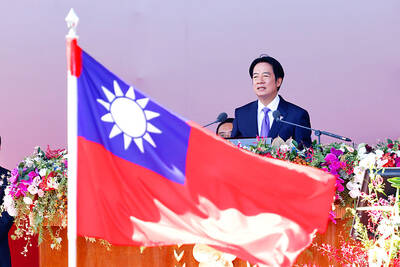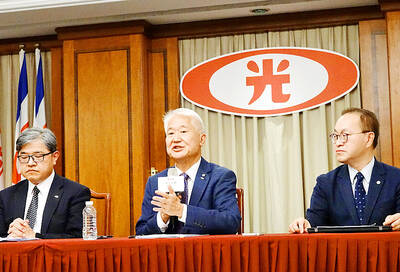A backlog of costly arms acquisitions by Taiwan could be forcing the navy to cut back on requests for frigates from the US, which threatens to exacerbate the widening tonnage gap in the Taiwan Strait as the nation decommissions ageing vessels.
Citing a Taiwanese defense industry source, Defense News said in a report published this week that the navy could request two — rather than four, as initially planned — decommissioned long-hull Oliver Hazard Perry-class frigates as excess defense articles (EDA) from the US.
The article said the plan to acquire the four frigates was cancelled late last year because of cost and technical considerations, adding that the military was struggling to pay for roughly US$18 billion in weapons released by the US in the past four years.

Photo: Jimmy Chuang, Taipei Times
Although China Shipbuilding Corp (中船) is capable of building Perry-class frigates — it has built eight so far, known locally as Cheng Kung-class — the source told Defense News that acquisitions from the US would be the quickest and least costly way to add the much-needed vessels to the navy. Building them would cost upwards of US$2 billion, the source said, much higher than the “near-scrap” price under EDA, even when refurbishment and upgrade costs are added.
The Ministry of National Defense denied there were plans to request fewer frigates from the US because of budgetary considerations and added it was in negotiations to ensure the acquisition were fully operational rather than semi-complete or empty shells.
Still, the navy will be forced to decommission aging frigates in the coming years. Its eight 3,800-tonne Knox-class frigates, acquired from the US in the 1990s after nearly 20 years of service in the US Navy, are due for replacement, but so far such plans appear to have stalled.
If replacements are not found, the navy will be down to 18 vessels with more than 3,800-tonne displacement — four Kidd-class destroyers, eight Perry-class frigates and six La Fayette-class frigates — Defense News said. This would continue a downward trend in tonnage for the navy, which went from 43 destroyers and frigates above 3,000 tonnes during the 1996 Missile Crisis, 39 in 2000 and 18 after the Knox-class frigates are taken out of service.
Plans to produce smaller vessels in the 2,000-tonne range also appear to have been cancelled due to budget problems.
Since Taiwan’s acquisition of the Knox-class frigates, the People’s Liberation Army Navy (PLAN) has commissioned a number of heavy-class destroyers and frigates, both Russian-made or domestically produced. According to Jane’s Fighting Ships 2011-2012, by next year, the PLAN could have at least 28 destroyers and frigates with displacement of more than 3,000 tonnes, with possibly more in production.
While not all of the PLAN’s combat vessels are intended for a Taiwan contingency, the balance of power at sea in the Taiwan Strait continues to shift in China’s favor, especially if no way is found to replace vessels that are due for decommissioning.
Some navy analysts, including James Holmes of the US Naval War College, have argued that rather than embark on a tonne-for-tonne race with China, Taiwan should focus its efforts and finite budgets on developing fast-attack craft such as the 170-tonne Kuang Hua VI missile boat.
So far, 31 KH-6s, divided in three squadrons, have entered service.

People can preregister to receive their NT$10,000 (US$325) cash distributed from the central government on Nov. 5 after President William Lai (賴清德) yesterday signed the Special Budget for Strengthening Economic, Social and National Security Resilience, the Executive Yuan told a news conference last night. The special budget, passed by the Legislative Yuan on Friday last week with a cash handout budget of NT$236 billion, was officially submitted to the Executive Yuan and the Presidential Office yesterday afternoon. People can register through the official Web site at https://10000.gov.tw to have the funds deposited into their bank accounts, withdraw the funds at automated teller

PEACE AND STABILITY: Maintaining the cross-strait ‘status quo’ has long been the government’s position, the Ministry of Foreign Affairs said Taiwan is committed to maintaining the cross-strait “status quo” and seeks no escalation of tensions, the Ministry of Foreign Affairs (MOFA) said yesterday, rebutting a Time magazine opinion piece that described President William Lai (賴清德) as a “reckless leader.” The article, titled “The US Must Beware of Taiwan’s Reckless Leader,” was written by Lyle Goldstein, director of the Asia Program at the Washington-based Defense Priorities think tank. Goldstein wrote that Taiwan is “the world’s most dangerous flashpoint” amid ongoing conflicts in the Middle East and Russia’s invasion of Ukraine. He said that the situation in the Taiwan Strait has become less stable

CONCESSION: A Shin Kong official said that the firm was ‘willing to contribute’ to the nation, as the move would enable Nvidia Crop to build its headquarters in Taiwan Shin Kong Life Insurance Co (新光人壽) yesterday said it would relinquish land-use rights, or known as surface rights, for two plots in Taipei’s Beitou District (北投), paving the way for Nvidia Corp to expand its office footprint in Taiwan. The insurer said it made the decision “in the interest of the nation’s greater good” and would not seek compensation from taxpayers for potential future losses, calling the move a gesture to resolve a months-long impasse among the insurer, the Taipei City Government and the US chip giant. “The decision was made on the condition that the Taipei City Government reimburses the related

FRESH LOOK: A committee would gather expert and public input on the themes and visual motifs that would appear on the notes, the central bank governor said The central bank has launched a comprehensive redesign of New Taiwan dollar banknotes to enhance anti-counterfeiting measures, improve accessibility and align the bills with global sustainability standards, Governor Yang Chin-long (楊金龍) told a meeting of the legislature’s Finance Committee yesterday. The overhaul would affect all five denominations — NT$100, NT$200, NT$500, NT$1,000 and NT$2,000 notes — but not coins, Yang said. It would be the first major update to the banknotes in 24 years, as the current series, introduced in 2001, has remained in circulation amid rapid advances in printing technology and security standards. “Updating the notes is essential to safeguard the integrity